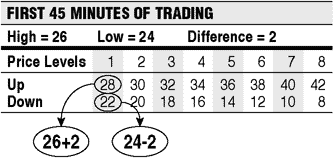NEW TECHNIQUES
At Mercy Of The Sun
Waiting For Market Time
by Jayant Sathe and Jayanthi Gopalakrishnan
Traders use everything under the sun -- and even the sun itself -- to time their trades.
Traders pay a great deal of attention to the trading activity seen during the first hour of the session in any given market. Many traders, in fact, feel more comfortable waiting for the markets to settle before placing their first trade for the day. Typically, most traders wait for half an hour before entering the market. Because of this, several systems have been developed that focus on beginning to trade after the market has been open for at least half an hour.

FIGURE 1: HERE'S HOW IT WORKS. Prepare yourself for both up- and downtrends by noting all the significant unit movements that the price will reach.
Trader Jayant Sathe devised a system that he successfully used based on
this premise of "waiting till the market settles." Sathe created
and applied his system specifically for stocks that trade on the Mumbai
Stock Exchange in India. He prefers to wait till the markets have been
open for 45 minutes before placing a trade. This 45-minute period is based
on the city's location and the behavior of traders. The length of the period
was selected based on:
1 The specific astrological positioning of the sun. The circle of the zodiac is divided into 12 houses. Each house extends over about 30 degrees, and the sun resides in each house for two hours. Sathe's astrological findings indicate that the sun should not be in its transition from one house to another.
2 Market observations, which indicate that within 45 minutes of opening, there seems to be some settlement in price activity and movement in a defined direction.
However, this period of 45 minutes may even be reduced to 30 or 35 minutes in the summer and/or winter period if it falls on the cusp of two houses.
THE SYSTEM
During the first 45 minutes of opening, Sathe notes the high, low, and volume of the stock he plans to trade. He then does the following:
- Adds the difference between the high and low to the high, or
- Subtracts the difference between the high and low from the low.
He continues adding or subtracting the difference to the previous results and then tabulates these numbers to better prepare himself for both upward and downward price movements. Figure 1 will help clarify how this is done.
He calculates the projections till the eighth level, in spite of the
fact that most of his observations indicate that the price hardly ever
reaches the fifth. He projects as far as the eighth level in case the market
becomes extremely volatile.
...Continued in the March 2001 issue of Technical
Analysis of STOCKS & COMMODITIES
Jayant Sathe, a consultant and researcher with a doctorate in psychology, studies astrology and its effects on the stock market. Jayanthi Gopalakrishnan is Technical Editor of STOCKS & COMMODITIES.
Excerpted from an article originally published in the March 2001 issue of Technical Analysis of STOCKS & COMMODITIES magazine. All rights reserved. © Copyright 2001, Technical Analysis, Inc.
Return to March 2001 Contents